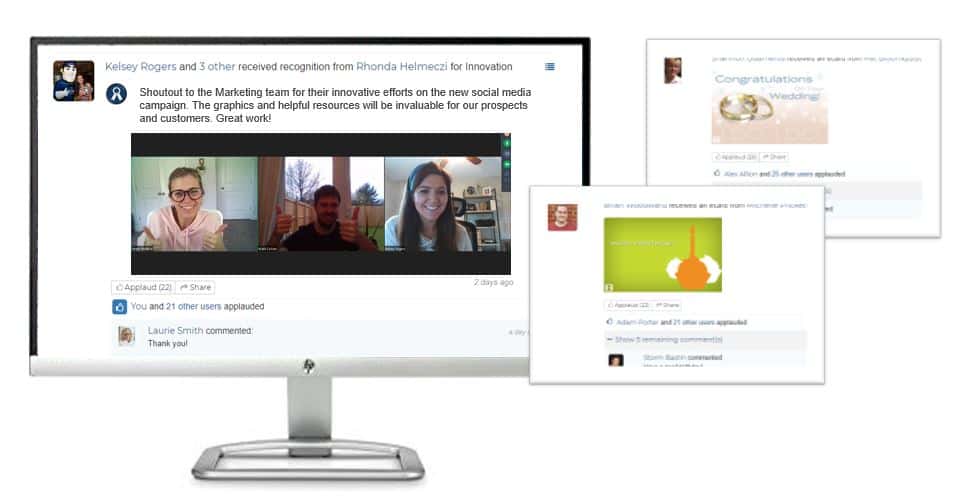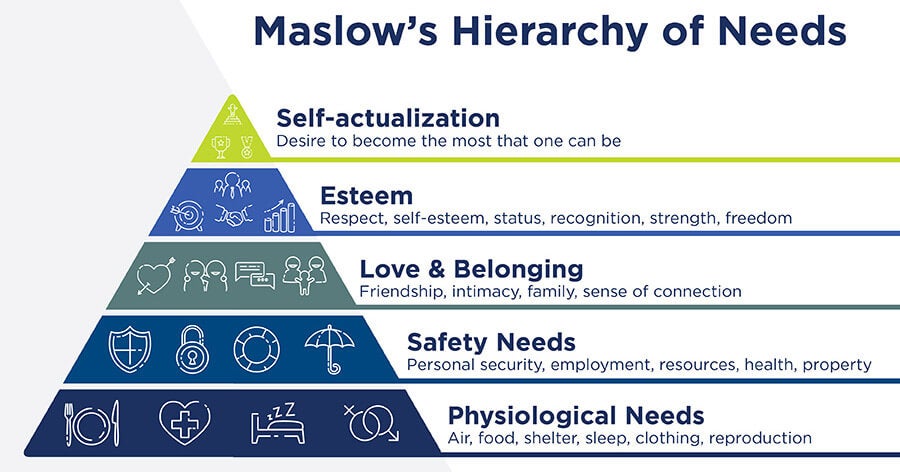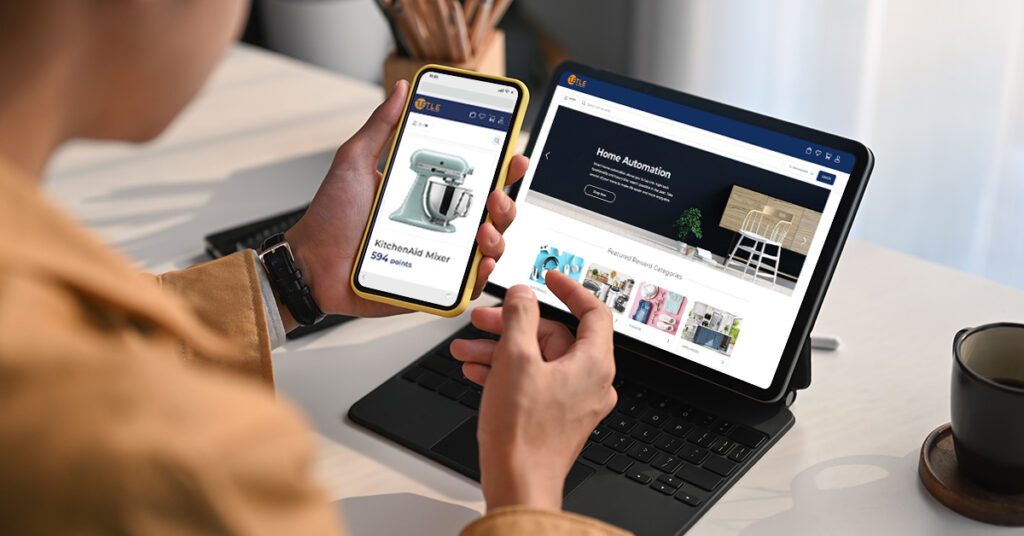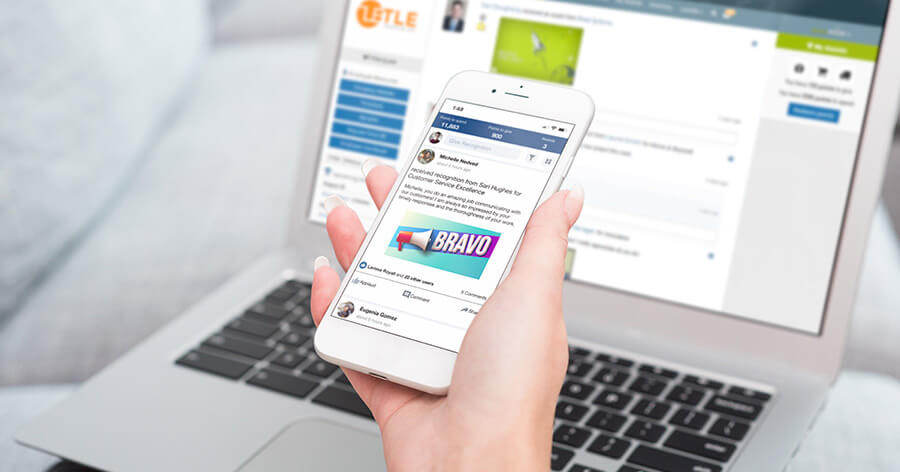April 4, 2022


Social recognition is one of the most powerful methods to recognise and engage your employees. It’s no secret that by recognising your employees you can build a strong culture of engagement.
Recognition is a powerful tool for every organisation. It allows leaders, managers, and colleagues to acknowledge and celebrate great achievements, there are so many ways to recognise your employees.
What is Social Recognition?
Social recognition, or peer-to-peer recognition, is a form of public acknowledgment and appreciation.
It helps to build meaningful relationships among employees and leaders. With a recognition programme, organisations can empower employees to celebrate achievements and awesome performance in real-time.
But what is it?
It often resembles a social media platform that most of us are familiar with already. Think of other social networks like Facebook, Twitter, and LinkedIn.


For many workplaces, social recognition programs include a digital communal forum (or feed) where employees at every level can participate. An employee can send gifs, memes, words of affirmation, and praise.
On a social recognition program, managers and employees alike are encouraged to recognise each other for all their hard work, achievements, milestones, and other contributions. Not all managers can see every single small achievement. But your peers see all the effort you put forth, despite how small it may be.
Social recognition software is a great option for managers and leaders to witness smaller accomplishments that go toward achieving greater goals.
Pro Tip: Accompany your social recognition platform with monetary and non-monetary rewards for a complete, and comprehensive employee recognition programme that is designed for your company’s needs.
RELATED: Social Recognition Software: What is it and Why Do You Need it?
Why is Social Recognition Important?
Social recognition feeds into the idea that humans are social creatures who value community. Many engaged employees feel a sense of belonging within the company. Additionally, it only amplifies the appreciation, allowing others to be aware of the recognition.
Can Maslow’s Hierarchy of Needs relate to recognition and employee engagement? Absolutely.


Published in 1943, Maslow wrote his first theoretical article about human motivation. He discusses five tiers of human needs for motivation: physiological, safety, belonging (social), esteem and self-actualisation. Physiological and safety needs are considered basic needs that are represented by tangible and monetary items such as salaries, safe working conditions, health benefits, etc. However, the top-tier needs are less basic. Why? Well, employee engagement and motivation are more complex and non-linear.
By understanding higher tiers, HR professionals and organisational leaders can build an employee engagement model that meets all the needs Maslow addressed. Social recognition is a method that employers can utilise to build a better sense of belonging, trust, loyalty, and meaningful interpersonal relationships.
Peer recognition helps employees to create a positive and measurable infrastructure within a company culture. To make it simple, it allows employees to celebrate success together as a community.
Benefits of Implementing Social Recognition Programs
Implementing a social recognition program can dramatically impact your organisation. It’s a simple and easy way to increase employee engagement, retention, and performance. Moreover, it can be a part of your strategy to build an awesome company culture that focuses on the entire employee experience.
Meaningful Relationships
Social recognition programs helps strengthen the relationship between employees, colleagues, and leaders. It allows for everyone (literally everyone) to interact with each other. Whether it’s a work milestone or a shout out for a job well done, you can empower employees to experience moments that can be very bonding.
Regardless of position, peer recognition programs are an important driving force in employee engagement and company culture. Even for those in a senior position, receiving recognition feels good (like all the hard work was worth it). Furthermore, this is a great tool for both traditional employees and non-traditional workers including remote employees.
Increased Employee Engagement
What is the key to productive, happy, and satisfied employees? Engagement.
With a social recognition program, employees can engage with their leaders and co-workers in a fun and interactive way. Studies have shown that organisations with engaged employees have decreased rates of turnover, 21% more profitability, and 17% higher productivity.
Employee Retention
Everyone loves to be told they are doing well! But can social recognition really retain employees? Oh, most definitely. Engaged employees are not likely to leave an organisation whether they feel seen, heard, or appreciated. Peer recognition allows companies to show their appreciation more frequently and openly.
Connected Company Culture
Think of a social recognition program as a professional social media outlet. Many programs include features from networks like Facebook, Twitter, and LinkedIn that allow for real-time, instant connection. Whether it’s a thumbs up, a "like," or a post, this type of platform makes employees feel more involved, engaged, and active in their co-workers' activities.
Additionally, social recognition can be integrated with other employee engagement initiatives. For example, employees can celebrate moments that matter by acknowledging work anniversaries and other milestones! This helps create a better sense of connection within the workplace.


Real Insight and Measurable Data
A social channel allows you to see real interaction, in real-time. It allows HR departments and leaders to measure employee engagement. With the implementation of peer-to-peer recognition, employers can measure how active their employees are, what days are more active than others, and the frequency of engagement. Over time, this type of data will help organisations improve their engagement strategies.
Moreover, it’s a tool that can help managers and leaders see all the little and big accomplishments throughout different teams.
Best Practices for Social Recognition programs
To improve your employee engagement, you can design and implement a social recognition program. This type of professional network can help you in your efforts to recognise your employees in a meaningful way. With peer recognition, your recognition program can be successful! But before you start planning, make sure to include the following best practices.
RELATED: Social Recognition Programs: 7 Ideas That Boost Engagement
Frequency Matters
Although recognition should occur consistently, social recognition should be executed on a regular basis. This will make employees feel valued for their efforts throughout the year. Organisations that provide frequent recognition to employees are less likely to see turnover and disengaged employees. So, make sure you are being consistent with your recognition.
Pro Tip: We suggest that your recognition should be at least a couple times of a month, if not weekly. This ensures that your employees will always feel valued.
Get Buy-In from Leaders
Leadership should always set the standard for recognition. Recognition that comes from the top-down creates an environment where appreciation, recognition, and hard work are valued. Make sure to train managers and leaders on social recognition programs, and their best practices. Managers and leaders who are proactive with engagement initiatives can improve their relationships with employees.
Real-Time Creates Positive Reinforcement
Positive reinforcement is a great tactic for employee performance. With real-time recognition, employees can easily compare what actions or tasks were praised. Typically, when specific behaviours or actions are positively recognised, they get repeated. So, it’s important to have a real-time feed for social recognition platforms that support your engagement tactics.
Inclusivity is Important
Leave no one out. Social recognition programs must be inclusive, from entry-level employees to leadership members. This encourages participation on multiple levels. Managers and leaders can see the different recognition posts, as well as comment and like them. With interaction like this, you can create a healthy environment for everyone!
Make it Fun
Although there are different types of public recognition like emails, or video conference calls, social platforms allow employees and users to have it! Implement platforms that allow users to customise their recognition posts with memes, gifs, pictures, emojis, etc.

